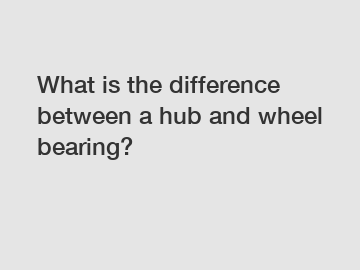What is the difference between a hub and wheel bearing?
What is the difference between a hub and wheel bearing?
Have you ever wondered how your car's wheels stay attached and spin smoothly? If so, you may have heard the terms "hub" and "wheel bearing" used interchangeably. However, despite their close relationship, these two components serve different purposes in your vehicle's wheel assembly. In this article, we will delve into the difference between a hub and a wheel bearing, shedding light on their individual functionalities and roles in providing a safe and smooth ride.
1. Definition and Functionality:

A hub is a metallic component situated at the center of a vehicle's wheel. Its primary role is to support the wheel and provide a stable platform for it to rotate around. Most modern vehicle hubs are designed as a single-piece unit that incorporates several components, including the wheel studs, bearings, and flange.
On the other hand, a wheel bearing is a set of steel balls or rollers enclosed within a metal ring. Its main purpose is to reduce friction between the rotating hub and the stationary axle shaft, allowing for smooth wheel rotation. Wheel bearings also support the entire weight of the vehicle and help maintain proper alignment.
2. Location and Installation:
Hubs are directly attached to the axle and house the wheel bearings. They are often held in place by large nuts or bolts, ensuring a secure connection between the wheel and the vehicle's chassis. Wheel bearings, meanwhile, are housed within the hub assembly, providing crucial support to the moving parts.
3. Load-Bearing Capacity:
When considering the difference between a hub and wheel bearing, it is important to note their load-bearing capacities. The hub's design ensures that it can withstand substantial vertical and lateral forces exerted on the wheel during acceleration, deceleration, and turns. On the other hand, wheel bearings are responsible for reducing friction and handling radial loads, which act perpendicular to the axis of rotation.
4. Wear and Tear:
Over time, both the hub and the wheel bearing can experience wear and tear due to constant use and exposure to harsh conditions. However, the signs of deterioration are different for each component. In the case of a failing hub, you may notice loose lug nuts, unusual noises while driving, or poor wheel alignment. On the contrary, worn-out wheel bearings often produce a grinding or humming sound, and you may feel vibrations in the steering wheel.
Conclusion:
In conclusion, while the terms "hub" and "wheel bearing" are often used interchangeably, it is vital to understand their distinct roles in your vehicle's wheel assembly. The hub provides a stable platform for the wheel to rotate around and supports the vehicle's weight, while the wheel bearing reduces friction and allows for smooth wheel rotation. By recognizing these differences and regularly inspecting and maintaining these components, you can ensure a safe and comfortable driving experience. So next time you hear a strange noise or experience steering irregularities, you'll have a better understanding of what might be happening between the hub and wheel bearing.
For more overhead conveyor guide wheel, overhead conveyor load wheel, guide wheel for overhead conveyorinformation, please contact us. We will provide professional answers.

Comments
0